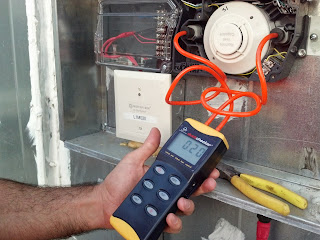 The Manometer we chose to use for this article is the Duct Checker manufactured by SDI. The Duct Checker is light weight, portable and battery operated making it easy to get to areas duct smoke detectors are commonly found. Simply connect the two provided hoses with variable size end plugs and power it on. Once the unit turns on, press down the "hold" button for three seconds to zero out the machine. Sort of like a scale. Now press the "unit" button until you arrive at the selection of "inH2O" on the bottom left of the screen.
The Manometer we chose to use for this article is the Duct Checker manufactured by SDI. The Duct Checker is light weight, portable and battery operated making it easy to get to areas duct smoke detectors are commonly found. Simply connect the two provided hoses with variable size end plugs and power it on. Once the unit turns on, press down the "hold" button for three seconds to zero out the machine. Sort of like a scale. Now press the "unit" button until you arrive at the selection of "inH2O" on the bottom left of the screen.The Duct Checker comes with two hoses that are designated for specific ports. One tube is marked as negative and the other positive. Make sure to place the hose end of the positive into the actual sample tube inlet. The negative tube will go into the exhaust port.
With the System Sensor DNR duct detector you will be looking for a reading of anywhere between 0.01 min and 1.11 max.
With this requirement clearly required in NFPA 72 2016 Table 14.4.3.2 section 17 (g)(5), as well as most manufacturer's documentation, you can expect to come across these at some point in your career. They are not too pricey so I suggest grabbing one from SDi and placing them in your inspection crew's service vehicles.



No comments:
Post a Comment